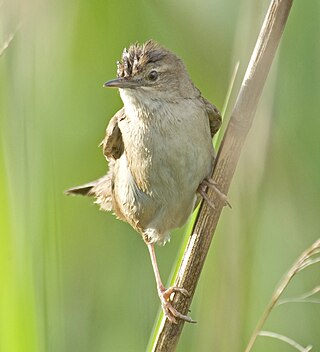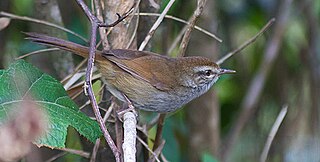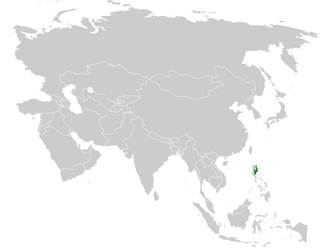
The grass warblers are small passerine birds belonging to the genus Locustella. Formerly placed in the paraphyletic "Old World warbler" assemblage, they are now considered the northernmost representatives of a largely Gondwanan family, the Locustellidae.

The common grasshopper warbler is a species of Old World warbler in the grass warbler genus Locustella. It breeds across much of temperate Europe and the western Palearctic. It is migratory, wintering in north and west Africa.

Savi's warbler is a species of Old World warbler in the grass warbler genus Locustella. It breeds in Europe and the western Palearctic. It is migratory, wintering in northern and sub-Saharan Africa.

The bamboo warbler or bamboo scrub-warbler is a species of Old World warbler in the family Locustellidae. It is found in Democratic Republic of the Congo, Ethiopia, South Sudan, Tanzania, Uganda, and Zambia. Its natural habitats are subtropical or tropical moist montane forests and subtropical or tropical moist shrubland.

The Taiwan bush warbler is a species of Old World warbler in the family Locustellidae. It is found only in Taiwan. Its natural habitat is undergrowth and grassland 1,200–3,000 m (3,900–9,800 ft) in elevation. It was first recorded in 1917 and named as a distinct species in 2000. The International Union for Conservation of Nature (IUCN) has assessed it as a least-concern species.

The Benguet bush warbler, also known as the Benguet grasshopper-warbler, is a songbird species. Formerly placed in the "Old World warbler" assemblage, it is now placed in the newly recognized family Locustellidae. L. seebohmi was formerly known as russet bush warbler, but that name is now restricted to L. mandelli, formerly included in L. seebohmi as a subspecies but now considered a separate species. It is found in the mountains of northern Luzon in the Philippines.

The spotted bush warbler is a species of Old World warbler in the family Locustellidae. It is found in the northern Himalayas, Yunnan and central China, in the countries of Bangladesh, Bhutan, China, India, Myanmar and Nepal. Its natural habitat is arboreal forests.

The Philippine bush warbler, also known as the Luzon bush warbler, is a species of bird in the family Cettiidae. It was formerly conspecific with the Japanese bush warbler. It is found only in the Philippines in the Cordillera Mountain Range of northern Luzon. It is found in tropical montane forest.

The chestnut-headed tesia is a small insectivorous songbird formerly of the "Old World warbler" family but nowadays placed in the bush warbler family (Cettiidae).

The tesias are a genus, Tesia, of Old World warbler. Though once included in the large family Sylviidae, more recent research placed it within a new family, Cettiidae. The four species inhabit undergrowth of montane forest in South and Southeast Asia, where they are resident or short-range migrants. They have longish legs and appear tailless, with (seemingly) only 8 rectrices. Their simple songs are fairly loud, and their nests are typically ball-shaped. Their name is derived from Tisi, the Nepalese name for the grey-bellied tesia.

The Bornean stubtail is a species of bird in the cettiid warbler family Cettiidae. It is endemic to the island of Borneo, where it inhabits forest floors and undergrowth in montane forests at elevations of 750–3,150 m (2,460–10,330 ft). It is a small, short-tailed warbler, measuring 9.5–10 cm (3.7–3.9 in) in length and having an average mass of 10.4 g (0.37 oz). The tops of the head and the upperparts are brown, with whitish underparts that turn grey at the sides of the breast and the flanks. The supercilium is long and buffish-brown, with an equally long dark grey eyestripe and a thin yellow eye-ring. Both sexes are similar.

The golden-mantled racket-tail is a species of parrot in the family Psittaculidae. It is endemic to Indonesia. Its natural habitats are subtropical or tropical moist lowland forest and subtropical or tropical moist montane forest up to an altitude of about 3,000 metres (9,800 ft).

The Sulawesi masked owl is a species of owl in the family Tytonidae. It is endemic to the Indonesian islands of Sulawesi, Sangihe and Peleng. It is listed by the IUCN as being of least concern.

The scaly-breasted kingfisher or regent kingfisher is a species of bird in the family Alcedinidae endemic to central and southwestern Sulawesi in Indonesia. Its natural habitat is subtropical or tropical, moist, montane forests.

The Sulawesi thrush is a species of passerine bird in the thrush family, Turdidae. It is endemic to the island of Sulawesi in Indonesia, where it inhabits evergreen montane forests at altitudes of 1,100–2,400 m (3,600–7,900 ft). Although it has a limited range and is not a common bird, the IUCN has assessed it as being a "least-concern species".

The cerulean cuckooshrike is a species of bird in the family Campephagidae. It is endemic to the island of Sulawesi in Indonesia. Its natural habitats are subtropical or tropical moist lowland forest and subtropical or tropical moist montane forest. Other common names for this bird include the Sulawesi cuckooshrike, the Celebes cuckooshrike and Temminck's cuckooshrike.

The Matinan blue flycatcher, also known as the Matinan flycatcher, is a species of bird in the family Muscicapidae. It is endemic to the island of Sulawesi in Indonesia. Its natural habitat is subtropical or tropical moist montane forests, and the species is threatened by habitat loss.

The dark-eared myza, also known as the lesser streaked honeyeater, is a species of bird in the family Meliphagidae. It is endemic to the island of Sulawesi in Indonesia. There are two subspecies, Myza celebensis celebensis which is found in mountainous parts of northern, central and southeastern Sulawesi, and Myza celebensis meridionalis from mountains in southern Sulawesi.

The Sierra Madre ground warbler is a species of passerine bird in the family Locustellidae. It is endemic to the island of Luzon in the Philippines, where it is found in the northeastern and eastern foothills of the Sierra Madre. Its habitat is in tropical moist lowland and the lower reaches of tropical montane forest. Along with its closest relatives, the Cordillera ground warbler and the Bicol ground warbler, it is one of the most elusive birds in the country due to its extremely shy nature. While not officially threatened, its population is said to be declining due to habitat destruction through deforestation.
Gunung Ambang Nature Reserve is a preserved area in the north of the island of Sulawesi in Indonesia. It is in a mountainous, little-explored region and contains a large number of indigenous plants and animals.



















